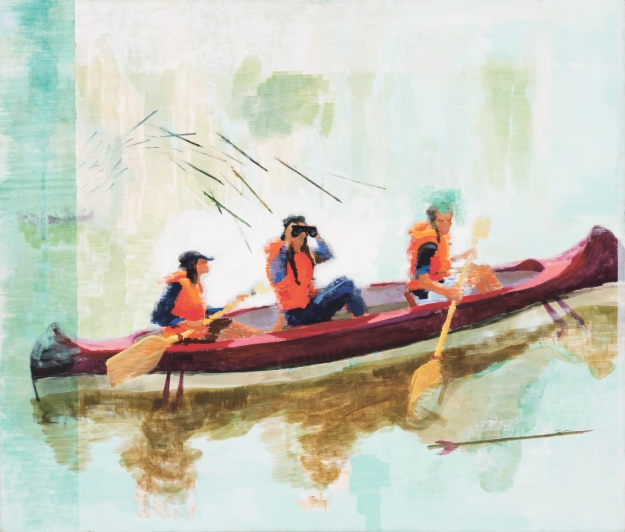Painting about painting
Painter Indrė Ercmonaitė (b. 1985) is not afraid of joking in her choice of characters and situations for her paintings. For example, her American Indians look very much like boating holiday makers. Or maybe they are boating holiday makers who imagine themselves as American Indians? It might take a while to answer this question and finally we would still return to what is most important for the artist herself – the art of painting. Ercmonaitė is very serious about painting.
UždarytiErcmonaitė, who graduated from her studies in painting at the Vilnius Academy of Arts in 2010, combines images from her personal experience with more general images that are familiar to the entire generation or even entire society. We have all most probably rowed a kayak or a canoe and read at least one book about American Indians at some stage. Still, all of us associate our adventures on water or books we have read with different things. This painting can be interpreted in a multitude of different ways, too: as a witty joke, as a foreboding or as an idea that everything we read or imagine does not go anywhere and sometimes unexpectedly descends on us like a swarm of arrows. It is rather easy to read the narration of the painting, because both the American Indian arrows and the bright life vests are easily recognisable.
Everything Else is Just a Headache is also very helpful in that respect. It sounds as if the author is sighing and is dismayed at the fact that one must inevitably return from the world of adventure novels or leisure time in nature to their daily life which is much less adventurous.
The title of the painting Everything Else is Just a Headache is also very helpful in that respect. It sounds as if the author is sighing and is dismayed at the fact that one must inevitably return from the world of adventure novels or leisure time in nature to their daily life which is much less adventurous. This is also confirmed by pale and poorly focused images in the painting that seem to be far away from us like our memories from the previous summer. To tell the truth, a closer look at the original slightly changes this impression.
The painting was created by using short, clear brush strokes and by abandoning clear contour line. Objects created out of separate brush strokes seem to remind of a computer monitor which reproduces images made of a multitude of individual pixels. It is only logical that this painting was created by an artist whose generation spent their childhood without computers, but had no difficulty taming them in their adolescent years.
The choice of characters in Ercmonaitė’s paintings varies a lot. She may portray generalised figures, human beings made of paint or even Jesus from a miracle-working painting, a snatch of a city or the Moon.
When Ercmonaitė was studying painting at the Vilnius Academy of Arts (2005–2010), there were more female students among the Bachelor students than male ones, but painting as a subject was mostly taught by male teachers. The situation has slightly changed now and there are a couple of young female lecturers at the department, too. However, most of the professors are male. Teachers have a major influence on young students of art. Their criticism or approval seems to be the most important thing in the world, their artistic touch and topics are being consciously or unconsciously copied. Some students cannot break free of their teachers’influence even after graduation. All this must have affected the young generation of female painters the majority of whom choose a neutral position when speaking about sex, gender or feminism. They mostly speak about culture or history of painting, including its current situation and its future. For example, Ercmonaitėspeaks about the art of painting as such.
The choice of characters in Ercmonaitė’s paintings varies a lot. She may portray generalised figures, human beings made of paint or even Jesus from a miracle-working painting, a snatch of a city or the Moon. Sometimes objects in her paintings turn into abstractions, because the artist is equally interested in both mysterious stories and the art of painting itself. All of this may be referred to as anatomy of painting. It is all about canvas, paint and its facture, separate layers emerging from a multitude of separate brush strokes and even underframes. It is no accident that one of her solo exhibitions was titled A Painting is Also a Human Being. Ercmonaitėoften uploads photographs on Facebook with a hashtag #cantstoppainting, which also shows how much she enjoys the very process of painting.
The smell of the paint thinner, the touch of a brush on canvas, the texture of paint and that feeling which is born when you are all alone in your studio with an artwork that is being born is an adventure without which the artist cannot imagine her life.
Our life may become ever more and more virtual, characters in paintings may keep changing, but the smell of the paint thinner, the touch of a brush on canvas, the texture of paint and that feeling which is born when you are all alone in your studio with an artwork that is being born is an adventure without which the artist cannot imagine her life. It is a promise to the viewer that the art of painting will change, but will remain alive. It is also an invitation not to stop after ‘reading’what has been depicted, but to continue further and to go on a new adventure accompanied by all the brush strokes and paint, which might be thick or barely covering the canvas, including all these layers and colours. This adventure may turn into an interesting and unpredictable experience, just like rowing down the river.




